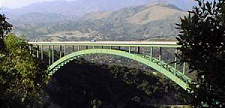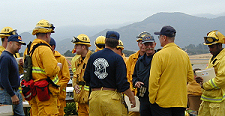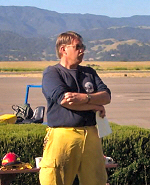
| Six hundred homeowners near San Marcos Pass can attest to the danger of wildfires. They've been battling the threat for many years. Santa Barbara County's rugged southern coast, where the Pass is located, definitely falls into what the state calls its "Wildland Urban Interface" danger zone. Residences near the Pass sit high above sea level, relatively isolated. Winding mountain roads inhibit evacuations. To help combat their peril, just over 20 years ago, the homeowners organized to form the Wildland Residents Association. WRA subsequently created (and now oversees) the San Marcos Pass Volunteer Fire Department, an all-volunteer group with initial attack capabilities as well as providing prevention services to the mountain community. Michael Williams, WRA director, among other improvements, in 2005 spearheaded the addition of SMPERS 1040 AM, the San Marcos Pass Emergency Radio System. an ALERT AM System. Below is a detailed account of how Williams, using a collaborative approach and professional follow-through, put the system in place. Perhaps his experiences can inform other emergency managers. Problem Definition Fires had caused residents of Santa Barbara County severe problems, especially related to traffic and evacuation routes. They became frustrated with the lack of information from commercial radio broadcasters. National broadcasting conglomerates had bought out many of those stations and, as standard practice, set them to auto-pilot during weekends, without staff on hand to report emergency news or alerts. Such stations, as a rule, cover vast areas and may or may not be inclined to interrupt commercially-sponsored programming with information unique to remote areas, such as San Marcos Pass. Research Non-commercial, limited-range stations, on the other hand, operate on dedicated public service channels. As opposed to disc jockeys, they are run by emergency managers themselves who have direct access and control over content. Broadcasts can be programmed to repeat instructions and offer news updates as long as necessary during brush fires or other disasters. Michael Williams' research on behalf of Wildland Residents Association revealed that these types of AM-band radio stations, already in use by national parks and in communities across the country, could be the answer. Initially conceived and developed as an experimental broadcast medium for Yellowstone National Park in the early '70s, the radio stations and the technology utilized had matured from frail tube-type transmitter equipment and audio tapes to totally reliable and fully solid-state transmitter equipment with digital audio that can be recorded/re-recorded from a distant location via dial-up connection. They now also can incorporate live broadcasts. The stations operate on dedicated public-service frequencies (530-1700 kHz), administered by the Federal Communications Commission. Through specific-area message encoding technology, they can be programmed to automatically receive and re-transmit national emergency and weather alerts to the specific areas being served. (Relevant county codes are programmed in.) They can be set to interface with flashing signs and community siren systems to encourage listenership. Designated emergency authorities can, via land line and cell phone, call in live or recorded announcements, such as evacuation instructions. Emergency Advisory Radio stations can be fixed or mobile and set to run individually or in groups to cover large areas. Each station, according to the FCC, may propagate to a radius of 5 miles from its transmitter/antenna system in all directions (equates to about 75 square miles). However, Williams discovered, there is only one supplier in the country that offers stations with all the features: Information Station Specialists. Solution The community decided it would establish its own San Marcos Pass Emergency Radio System (SMPERS) on 1040 AM to include a fixed and two mobile Emergency Advisory Radio stations. Each station in this 3-station grouping will be able to transmit its own broadcast on its own frequency. Or, all the stations can simulcast a streamed program on different frequencies at the same time. Each mobile station has dual-frequency capability. Caltrans was to erect reflective highway signs on both sides of San Marcos Pass, announcing SMPERS 1040 AM; and residents would be able to view information about SMPERS at WRA's website. As a testament to Williams' collaborative ability, local commercial broadcasters, when on duty, also agreed to announce the SMPERS call sign and frequency for emergencies. Williams coordinated the SMPERS project by approaching the Santa Barbara Fire Safe Council for program oversight to avoid inter-agency politics and gamesmanship. To a few naysayers who expressed doubt that WRA (a non-profit corporation) would be able to get a FCC license, obtain funding, build a station or successfully run it, Williams replied, "Ultimately, the WRA did it all without a hitch." The big and real supporters, he stated, were the California Transportation Department (Caltrans), California State Highway Patrol (CHP), local Red Cross, county sheriff's office and the Fire Safe Council itself. "AM radio is our next step in improving overall communications during emergencies," emphasized Williams, at the time. "When the power goes out and telephone lines are down with no computer and everything stopped, residents can turn on their AM radios to hear emergency advisories. During an emergency, designated people from state/local public service agencies call an answering-machine line and immediately put an emergency update on the air to the community." Equipment Stated Williams, "Our fixed ALERT AM station is up and running atop Painted Cave at San Marcos Pass in Santa Barbara, 2,800 AMSL, with a clear overview of the San Marcos Pass (State Route 154) and the mountain communities. The transmitter and antenna are in an isolated-style setup. The transmitter is so small it sits in a weatherproof box about the size of a bedroom dresser. And the antenna looks like little more than a whip antenna on a telephone pole with some wires hanging off it. This is the same location of the community's VHF repeater, so necessary utilities and phone services are already in place. It can be monitored on any vehicle or portable commercial AM radio. We plan to add two trailer-mounted mobile stations soon. Grant funding is in process," Williams stated at the beginning of the project in 2005. When asked if he encountered any problems during the installation, he responded, "None. The equipment arrived complete and was quickly adapted to our requirements. The antenna was challenging to tune. I suggest that anyone taking this project on should plan on utilizing a good electrician and/or radio tech, if they want to do it right. However, the truth is, just about anyone could put this station up and get it on the air. We just wanted perfection, and got it!" The only complaint Williams says that he received when the system first became operational was that the signal could not be heard over as wide a range as a commercial broadcaster's. "It is sometimes difficult for the public at large to understand that commercial broadcasters covering wider areas often cannot attend to unique concerns and interrupt commercially sponsored programming to repeat emergency instructions to the extent needed. This is the advantage of specific-area broadcasting," Williams emphasizes. And commercial stations are not always manned, i.e., often run recorded programming. WRA installed the system themselves. "The process was not difficult at all. The only problem we ran into was the weather," Williams intoned. "I have purchased millions of dollars of communications equipment over the last 30 years. Information Station Specialists is one of the best vendors ever. The equipment is also well documented in the service manual. Aside from the technical issues of antenna tuning and signal readings, it is a true plug-and-play system." Funding Williams admits funding is a big deal. "Even though the cost per station is relatively minimal in the overall scheme of things for most organizations, discretionary funds are hard to come by for most public agencies." "The funding is out there," continues Williams, "but writing grants requires skill, the ability to justify a program and associated costs." Williams believes that if more emergency managers thought "outside the box," they could build Emergency Advisory Radio Station costs right into other public projects, such as new schools, fire stations and city halls. "These agencies," he concludes, "often don't think twice about dropping millions of dollars to switch over to 800-Mhz-trunked radio systems." Download a copy of Williams' actual system proposal. Accountabilities WRA installed the ALERT AM system using Information Station Specialists' instruction manuals and live phone technical support. Information Station Specialists offers both partial and turn-key installation support and has a network of reps across the country who can visit sites. Though, in essence, the WRA owns and manages the station itself, Michael Williams regularly taps local officials and broadcasting talent to create emergency broadcasts. Success is assured via interpersonal interaction with these folks and a set of well-written policies and procedures to run on-going operations. Williams is the driving force behind establishing these aids. See example. As stated above, the Santa Barbara county/city fire departments, Caltrans, the state highway patrol, local Red Cross and sheriff's department helped actualize the WRA's vision for improved emergency communications through the Emergency Advisory Radio system. Explained Williams, "Our radio station SMPERS is officially on the air on 1040 AM 24/7, ready to provide updated information, as soon as it becomes available. The CHP [CA Highway Patrol], county fire agencies and Caltrans [CA Department of Transportation] have direct access to make emergency announcements. We usually run about 10 minutes of broadcasting that repeat as needed." Because a number of people are involved, it's important to have someone visibly in charge. Right now, Williams is the "go-to" guy. "The stations have to be run like a business," he says. "Public safety won't work otherwise. We interact with local agencies in a professional manner. Also, emergency announcements affect people's lives. Someone could get hurt, if we screw up; or, we could get sued. So we keep records of our broadcasts. We also have documented policies and procedures (download example) "It can't be a competition with commercial broadcasters either. I've found they can either be your friend or you enemy; there's no in-between and no competitive stance. We work with them in a professional manner so they encourage listeners in our area to tune to our stations for instructions." Williams likes to work with local radio talent to create regular programming. As it happens, his uncle, Jim Williams, a professional broadcaster most of his life, served as the voice of SMPERS. "Les Carroll and Geren Tiltz from KZSB-1290 AM handle professional recording and sound uploads. Mark Ward is the voice and producer behind the Santa Barbara Sheriff Department's spots. The station is also connected to the California Office of Emergency Services for broadcasting emergency messages to the Santa Barbara area automatically," Williams recounts. This level of involvement from government officials and local talent reveal Williams' proclivity for collaboration to ensure valid broadcasts listeners can rely on. Broadcasts The SMPERS 1040 AM (call sign WQBT795) system transmits emergency information, weather alerts, special road construction and closures as well as current fire updates. The first official emergency use of the station was for a rock slide on Old San Marcos Pass Road in the same area as a big slide last January. For this first use, the director of public works called Williams at home after hours and asked him to put the information on the air. "This was a big win for us on several fronts," Williams says. "The station was also used during a major evacuation drill in Mission Canyon. Bruce Carter, manager of Santa Barbara County Office of Emergency Services, requested support," recounts Williams. "The drill was a joint exercise with the City of Santa Barbara and the County of Santa Barbara as well as the Red Cross, ARES, other local support groups and SMPERS." Williams plans to reserve station use for serious emergencies, not "scream 'Fire' for every little call." "The phone interface for creating and updating broadcasts worked really well," Williams adds. "For example, Marta Bortner of Caltrans calls in her broadcasts from afar. They sound like they were done right in a studio." "At this point," enjoins Williams, "we like the local broadcasting concept, where each station can have its own local information. Some programming might be uniform on all stations, however. We planned to use the same frequency, so it becomes the common emergency go-to frequency." It should be noted, here, that the mobile stations Williams plans to add can have dual-frequency capability, so other broadcasts could run on other frequencies if needed. See broadcasts in the "Sidebar," left. Public Relations Just as important as acquiring funding, picking/installing a capable system, and running credible broadcasts is marketing the program, so the Emergency Advisory Radio System can achieve its intended purpose.  "Name recognition is important," shares Williams. "We created a logo that goes on everything, i.e., our website, banners at education sessions, such as Red Cross functions." Media coverage is an aspect Williams didn't overlook either. "We've had coverage we couldn't have bought, NPR for example." And Santa Barbara County News said, "Locals can tune in to WQBT795 to get updates on everything from road closures and brush fires to local weather. More importantly, it can provide emergency information about bigger fires, mudslides and evacuations." In addition, the WRA plan incorporated strategically placed highway signs (provided by Caltrans, as mentioned above) to tell motorists within range about the broadcasts. Conclusions Williams advises other communities considering an Emergency Advisory Radio System: "Have a plan. Have a goal. Justify your program in writing. Be professional and work with everyone. Do not upset the commercial broadcasters. Set policy, and provide supervision. Do not just plug it in and take a vacation, assuming it is all going to run on automatic. Programming takes thought, planning, script-writing and some professional talent, if you want to sound professional and have credibility with the public. Also pay attention to liability. Keep records; and keep your scripts. Note the name and time of any emergency information. We write scripts and keep them for the record. Professional recording is done to keep the station sounding fresh and credible. Too many umms, ands and uhs will sound amateurish. "The stations are a public relations and marketing tool. We might not be able to advertise, but that does not mean we cannot give a professional voice to our organization. The result is a positive public image that helps support all our programs." Williams believes that involving local officials goes a long way toward ensuring success. "Because of our approach, our relationship with other agencies and our credibility improved. The ability to provide local announcements and emergency information also improved, significantly, for an overall better result." "One last thought," says Williams. "These stations are great, but they are only as effective as those managing them. It's not wise to put a station on the air (just to squelch community complaints about a lack of information) then abandon it because of the time involved in keeping programs current. Anyone purchasing a station should be committed to it to receive the true benefits of the product." The broadcasts fill an important communication gap for residents and visitors of San Marcos Pass. "Not bad for a group of volunteers," Williams notes. No, not bad at all, the community-minded would likely respond. |
PO Box 51, Zeeland, Michigan, USA, 49464-0051, Phone 616.772.2300, Email
• • •




